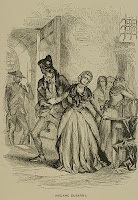
Simply put, my father makes the best Manhattan.
I don't know what makes it the best. It could be nostalgia. It could be the ratios, the precisely limited amount of bitters, the maraschino cherry juice (yes, the bright red kind). It could be the sheer consistency of the recipe - year after year, not one of these magnificent drinks has wavered in flavor. Each encounter with a Manhattan made by my father is like a reunion with your own flesh and blood. If there was one thing I could have learned from this, it is
don't muck about with perfection.
So, like a proper son, I
did muck about. And as a result, I lost the magic touch.
I used to make a good Manhattan; slightly more bitters, slightly more vermouth. In fact, in the quest to find my own take on this classic - my own perfectly rendered Manhattan - I have tried scores of different bourbons and ryes, many types of bitters and vermouths, and so many damned ratios that I have effectively forgotten how to make the same drink twice. I have made some outstanding cocktails, real beauties, with rich, complex flavors. I have made many that were merely so-so. The problem is, I have no standard to which I can adhere. I am always trying some new thing. It's hit or miss. Until, that is, I do it Dad's way.
That's why, in honor of my father's recent October birthday, I decided to write about his consistently delicious, soul-warming,
old friend Manhattan. A chance to come home, so to speak. The Prodigal Son. It is like hitting the default button, starting over, finding the trail out of the wilderness. For me, it is the control in the experiment. It is the measure by which all other endeavors must be judged.
I would like to say I can remember the first time I was old enough to be offered my initial Manhattan. It was probably Christmas Eve. It probably came, as it always does, brimming with amber liquid and mystery, that dark cherry nestled deep in the glowing heart of the drink. Here was the special-occasion cocktail I had seen my father sip on for most of my life, always during gatherings or holidays. It represented festivity and camaraderie. It was always a libation indulged in as a group: the family raising a toast; a boisterous group of friends carefully clinking glasses, trying not to slosh. On trips to visit my mother's family in London, Dad would bring Wild Turkey, and would introduce the English relatives to this uniquely American cocktail. Everyone there who tasted it remembered it - such a cocktail was almost completely foreign to England at the time - and it was in demand at every visit, year upon year.
As for me, I loved it immediately. Spicy, sweet, floral, woodsy, each sip ushering a fugue of flavors, developing and restating themselves, from toasty vanilla to nutmeg and a mere hint of cinnamon, to something like burnt sugar and charred wood. Such a remarkable drink undoubtedly fostered my (quite possibly unhealthy) need to discover what transforms a good cocktail into a beautiful experience.
So here, a little over week past my father's birthday, I offer the king of Manhattans: Dad Bradley's.
My Father's Manhattan
- 4 parts Wild Turkey 101 bourbon
- 1 part sweet vermouth (Martini & Rossi)
- Dash of Angostura Bitters
- Small barspoon of liquid from the maraschino cherry jar
Note that I say
parts, not ounces. The number of ounces that comprise four parts is up to you. Shake the ingredients with ice until very cold (about a 20-count) and strain into a chilled martini glass. Garnish with a maraschino cherry (and no, not the fancy kind... the artificially colored kind).
 |
| My brother, Ben, and father, Damon - happy with Manhattans |
I have quite recently introduced my father to
Carpano Antica, a particularly flavorful sweet vermouth, the "ancient formula," and
Luxardo's fancy marasca cherries which are tart and delicious. And Dad politely agrees that these tastes indeed add new dimensions to the old classic Manhattan - and he may mean it. But ultimately, I like the Manhattan best when it is made the unfussy way Dad makes it: using the old, sticky bottle of Martini & Rossi, the trusty Wild Turkey 101, and the bright red cherries. And just a
dash of bitters.
Here's to you, pops. (Forgive me if I don't say "bottoms up" this time.)
















